Health
Mixed Berry Smoothie Without Yogurt

Learn how to make my super easy, mixed berry smoothie recipe without yogurt! It’s healthy, creamy, totally delicious, and has no added sugar! Naturally sweetened and full of nutrients, this refreshing drink is ideal for anyone who is looking for a perfect quick breakfast or afternoon snack. All you need is 2 ingredients and 5 minutes and you’ll have this easy smoothie ready in no time!
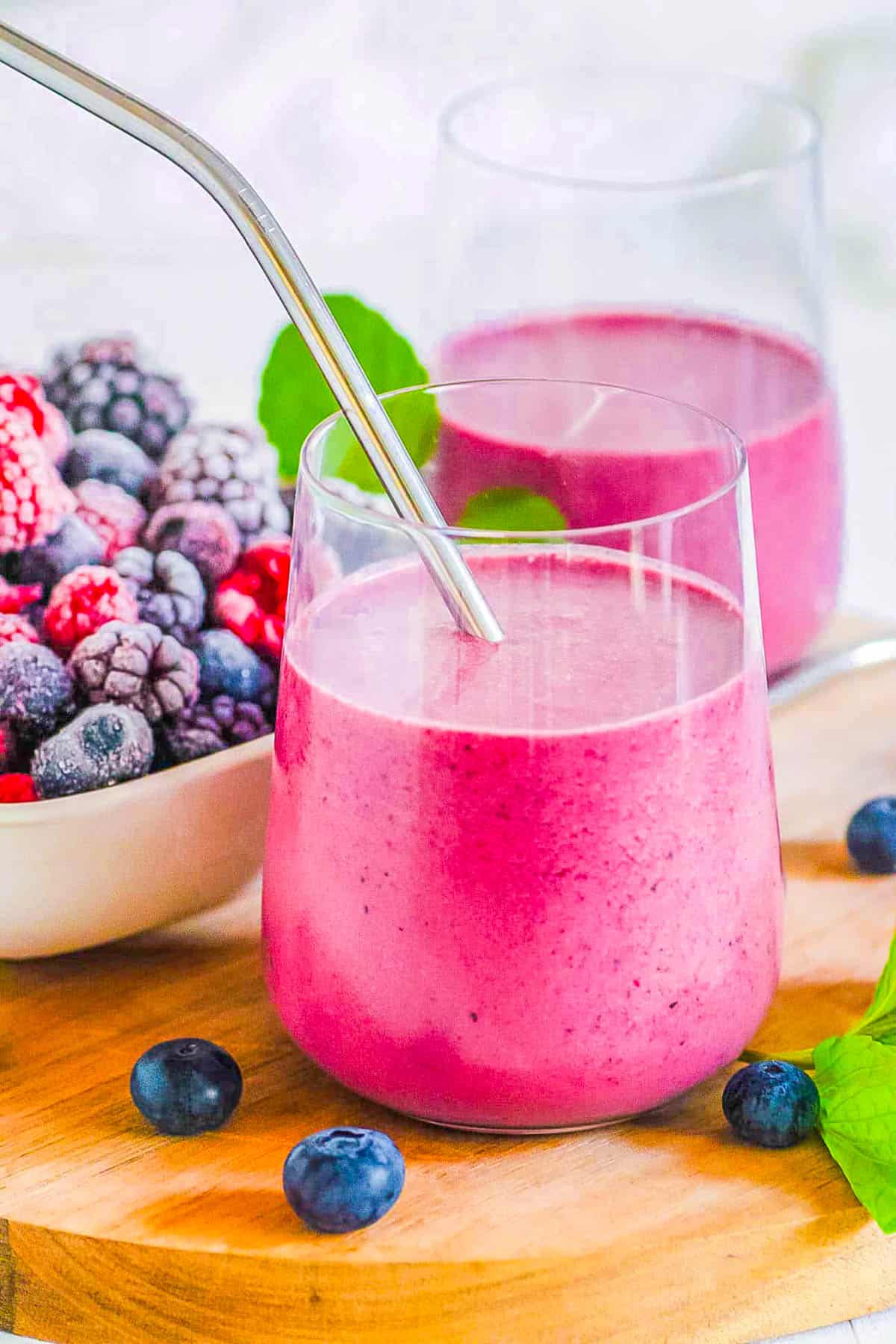
I love whole fruit juices and smoothies. I also love that smoothies made with fruit don’t really need any added sugar – because fruit is already so naturally sweet!
I will often make smoothies as an easy way to get my daily servings of fruits and vegetables – it’s like a little mini-meal when made correctly.
And my healthy mixed berry smoothie recipe is no exception! It’s so simple, but also super customizable – so you can enjoy it as is, add in more fruits, or add in veggies too!
I’m also all about 5 minute recipes, especially in the morning when I need something healthy, fast and filling. That’s why this recipe is one of my go-to morning drinks.
And if you’re as big of a smoothie fan as I am, you should also try this fruit and vegetable smoothie – also made without yogurt, or this kale smoothie, dragon fruit smoothie, and spinach and ginger smoothie, too!
I like making frozen fruit smoothies at home, because then I can control the sugar, and the frozen fruit makes it super creamy and indulgent.
Most smoothies that you’d get at a restaurant have tons of unhealthy sugary additives (frozen yogurt or fruit juice like orange juice or apple juice are common) – which I have found are just not necessary to make smoothies taste good!
You might be surprised, but I promise, you actually don’t even need yogurt to make a creamy and rich smoothie. You just need the right proportion of ingredients, and after testing so many smoothie recipes, I know I’ve come up with the perfect blend for this recipe.
Thanks to the frozen berries, all you need is 5 minutes and a blender to make this super healthy frozen berry smoothie recipe. You can also scale this recipe up or down as needed – I’ll often make it for my whole family because my kids love it too!
For a more filling option, feel free to throw in some protein powder which makes this a great option for a meal replacement. See my variations below for more ideas on how to customize this. And no matter how you make it, you won’t be able to get enough of this tasty and sweet treat!
Latest Recipe Video!
🥘 Ingredients
My ingredients list for this mixed berry smoothie couldn’t be any simpler! You can make this 2 ingredient smoothie with basically no prep time! Here’s what you need:

Frozen Berries: I used a mixed berry medley that had blueberries, blackberries, strawberries, and raspberries – and I prefer making this smoothie with frozen berries because of the texture. But you can use any combination of your favorite berries that you like. You can also use fresh berries, but then you will need to add ice cubes.
Milk: I like to use a dairy-free milk to keep this recipe vegan and plant-based, but you can use any kind of milk you like! It works great with almond milk, oat milk, soy milk, regular low fat dairy milk, or another dairy-free milk alternative. If choosing plant-milk, just be sure to use one that has no added sugar. I have found that using regular organic 1% milk makes this drink even sweeter and tastes just like a milkshake, which my kids love! This recipe makes a frozen mixed berry smoothie without yogurt – but you can use plain yogurt or Greek yogurt instead of milk for a thicker smoothie.
Optional Added Sweetener: Because of the frozen berries, I find that this smoothie is already naturally sweet on its own, but if your berries happen to be especially tart, feel free to add a dash of your choice of sweetener before serving. Honey, agave, maple syrup, monk fruit and stevia are all great options. You can also add ripe bananas, vanilla extract, or even medjool dates for more sweetness (just make sure to re-blend after adding any sweetener so it gets combined well).
🔪 How To Make A Berry Smoothie Without Yogurt
My frozen berry smoothie without yogurt literally has just 2 steps! All you need is a blender (or a hand blender). See my video below to watch how to make it! Here’s how to make a simple berry smoothie:
Dump & Blend! First I add the milk to a blender, then I’ll add the frozen berries. It’s important to have your liquid go in first for easy blending. Puree until smooth and creamy. You can also use a hand blender if you have one at home.
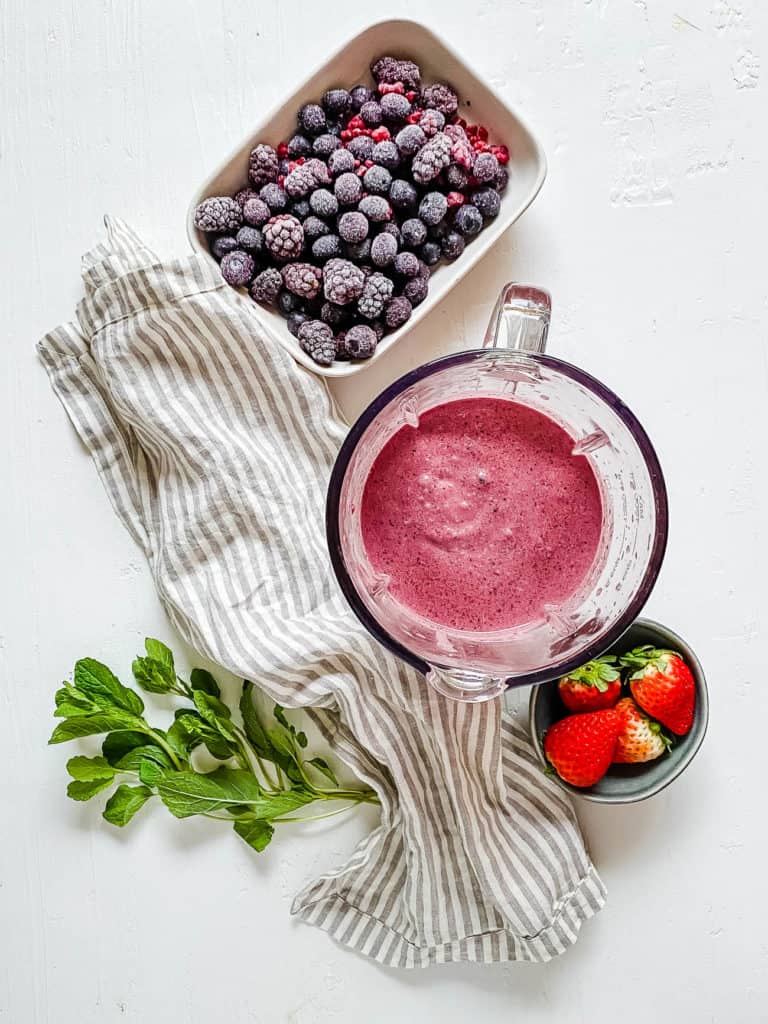
Serve: Add sweetener to taste (optional). Blend a few more seconds to combine. When it’s ready, I like to pour it into a tall glass and garnish with fresh herbs or fresh berries. I recommend serving this triple berry smoothie recipe immediately!
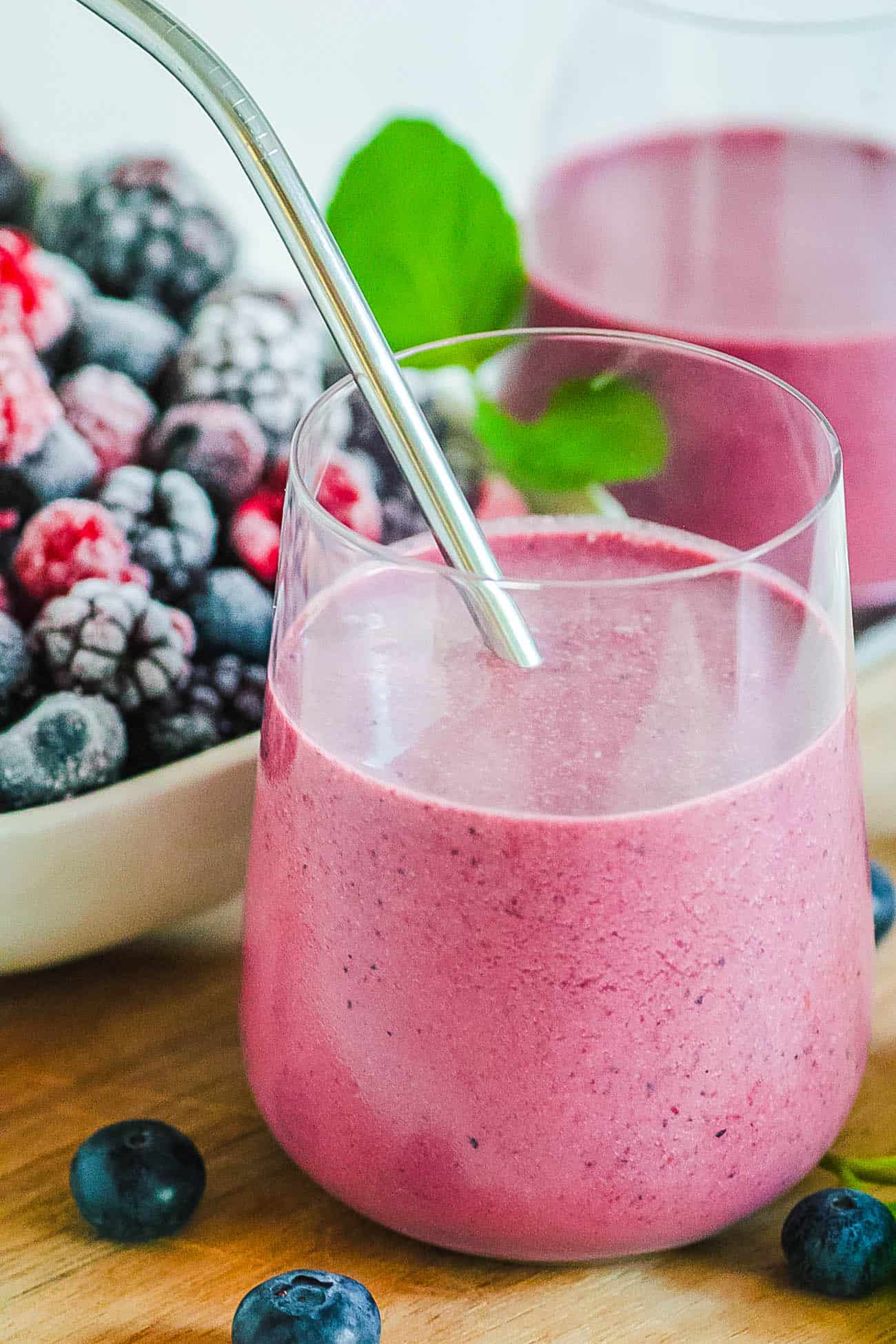
My #1 Tip for this easy berry smoothie recipe is to use a high powered blender! Since you’re blending up all those frozen berries with seeds, you need a blender that will pulverize the seeds of the berries, so you end up with a super smooth texture (and not a strawberry-blueberry-raspberry smoothie filled with seeds!) A regular blender will work, but won’t give you that same super smooth, milkshake-like consistency.
Other Tips To Keep In Mind:
- Use a frozen berry mix for convenience, and also to create a thick and cold texture.
- Add the milk first, followed by the frozen fruit. This helps to keep the fruit from getting stuck on the bottom of the blender.
- Start slow, then speed up. Start blending at a low speed to break up the large chunks. Gradually increase to high speed until the mixture is smooth. If needed you can also stop the blender and scrape down the sides to ensure all ingredients are evenly blended.
- Adjust the consistency. You can make this mixed berry smoothie with milk or without, or just use a little bit of milk for a more slushy-feel. You can always add more liquid if you want a thinner consistency after you blend it the first time!
- You can make this recipe ahead of time and store it for 24 hours in the fridge. If you do meal prep this smoothie, make sure to stir it well before serving or pop it back in the blender for a minute or so. I don’t recommend freezing this smoothie, especially if you use dairy milk or add Greek yogurt, as the consistency will change once it’s defrosted.
- This is a one serving smoothie recipe, but you can easily double or triple it if you’re making it for the whole family! Just make sure your blender is big enough to accommodate!
📖 Variations
Use Fresh Berries: Instead of using a frozen berry medley use your own blend of your favorite fresh berries (or fresh + frozen mixed). I love using fresh raspberries, blueberries, and blackberries, but when using fresh berries, I’ll also add half cup of ice to achieve the same texture as with frozen berries.
Try Different Fruits: Diced apples, diced pears, fresh pineapple or frozen mango would all taste great in this recipe! My kids love it when I add in pineapple and mango. You can even make a mixed berry banana smoothie by just adding in frozen banana along with the berries.
Easy Mixed Berry Smoothie Bowl Recipe: When I have a little more time, I’ll pour this drink into a bowl and top it with sliced bananas, oats, coconut, nuts, seeds, granola, fresh berries, honey, maple syrup, or whatever I have on hand to take this smoothie recipe to the next level.
Add A Boost Of Protein: When I need something more filling, I’ll make a mixed berry protein smoothie by adding a scoop of my favorite plant-based protein powder. I recommend an unsweetened or sugar-free protein powder. While I prefer a plant-based protein, any type of protein powder will work. For extra protein, you can also add 1/2 cup or more of plain Greek yogurt (I don’t recommend vanilla Greek yogurt, as that has too much added sugar).
Healthy Fats: Feel free to add your favorite nut butters or seeds like almond butter, peanut butter, hemp seeds, chia seeds, or flax seeds for added fat and protein. Avocados are a great addition to boost healthy fats and creaminess.
Use Natural Sugars: Instead of adding honey or maple syrup (added sugars) to enhance the sweetness, I recommend fresh or frozen bananas, mangoes, or dates instead!
Extra Greens: To get your serving of veggies and fruits for the day, feel free to add fresh spinach or baby kale to this frozen berry smoothie with milk. They’ll blend right in, you won’t even be able to taste them. The greens are a great way to get some extra fiber too!
🍽 Serving Suggestions
This mixed berry smoothie with no yogurt pairs well with breakfast, snacks, and other kid-friendly recipes. I also like it by itself for an afternoon treat! Here are some of my favorite ways to serve it:
Breakfast: For a sweet, grab-and-go option, I’ll give this breakfast smoothie a boost by enjoying it alongside my pumpkin protein balls to round out the sweetness. For a low-calorie option, this egg white omelet would pair nicely with this smoothie.
Lunch: When I’m looking for a more filling lunch, I’ll often pair this smoothie with my vegan hummus avocado wrap for a hearty snack!
Kid-Friendly Recipes: My kids love turning this into a frozen berry smoothie bowl, and grabbing a handful of my low calorie granola as a topping for a for snack time! Sometimes we’ll pair it with savory snacks too like these air fryer mozzarella sticks for a delicious after school snack.
🧊 Storage Directions And Serving Size
Serving: This recipe makes a single serving mixed berry smoothie without yogurt or banana. If you are making this for your kids and family members, just double or triple the recipe as needed. You can also add ingredients (such as my variations above) to stretch the recipe for additional servings.
Refrigeration: Store any leftover smoothie in the refrigerator for up to 3 days in an airtight container or mason jar. I find that before serving again, it helps to blend for about 30 seconds, and sometimes I’ll even add ice or frozen fruits before blending!
❓Recipe FAQs
You don’t need to add ice to your smoothies if you are using frozen fruit. The frozen fruit acts as the ice that makes it thick and creamy. However, if you are making with fresh fruit, and desire a thick and cold texture, add about 1/2 cup of ice. Add the ice after the milk to the blender so that it can easily blend and you don’t end up with chunks of ice.
You can easily make a smoothie creamy without yogurt by adding in other ingredients that have similar properties to yogurt! Some of my favorite substitutions for yogurt are: a frozen banana, half an avocado, 1/4 cup silken tofu, 1/4 cup coconut milk or coconut cream, or any nut butter of your choice!
Honestly, just about any milk, plant-based milk, or coconut-based-product will work in a smoothie. I just recommend avoiding fruit juices as they have added sugar and are quite thin – consistency-wise, and water – which has no flavor and will just make your smoothie watery. I also don’t recommend using ice cream or frozen yogurt because that will turn your smoothie into more of a dessert than a healthy drink.
To avoid a watery smoothie, I recommend starting with less liquid and adding more as needed to achieve the consistency you want. Other things that can help make your smoothie rich and thick (vs. watery) is to use only frozen fruits or frozen veggies, and add a thickener like avocado, protein powder, or nut butter.
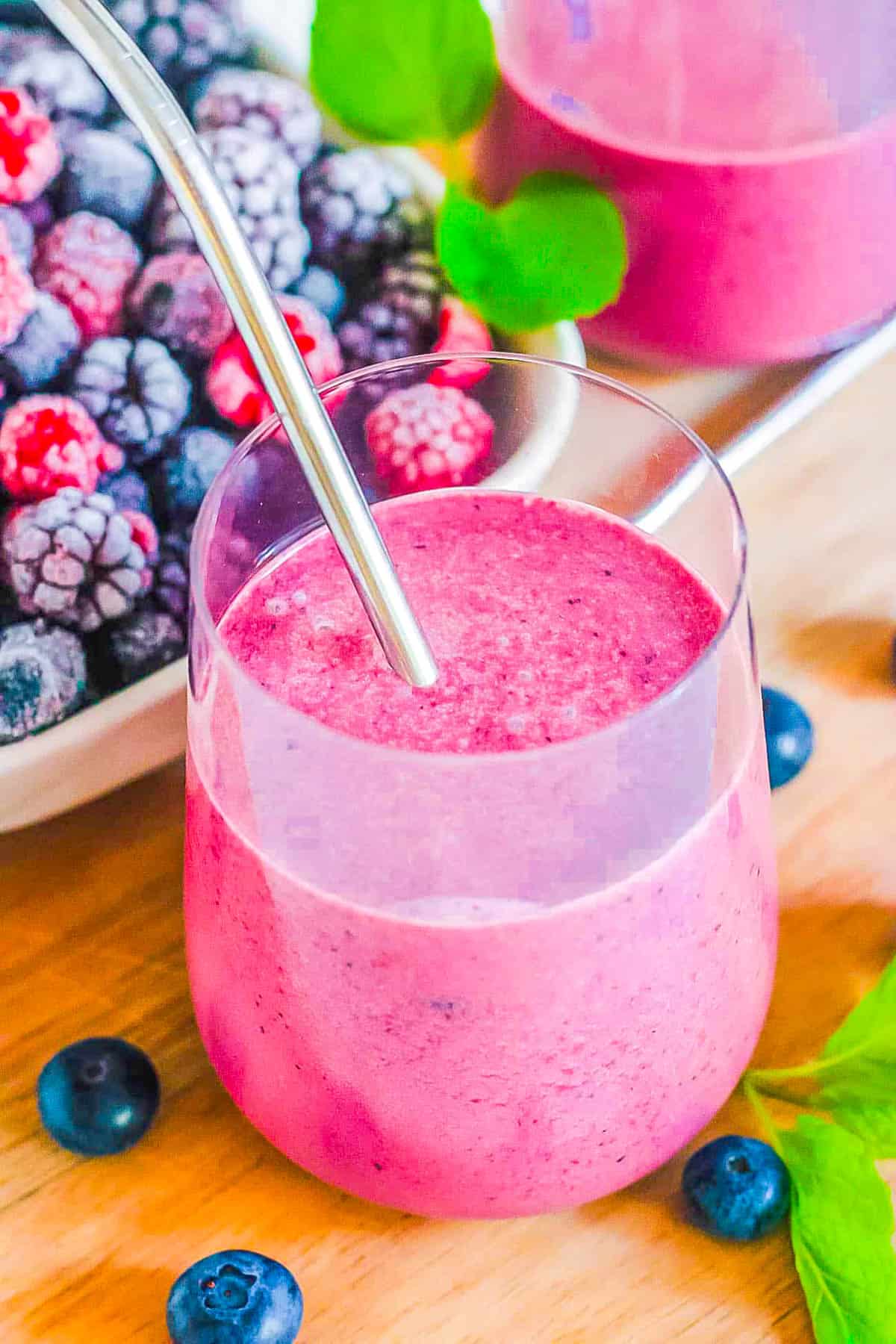
Want to Save This Recipe?
Enter your email & I’ll send it to your inbox. Plus, get great new recipes from me every week!
By submitting this form, you consent to receive emails from The Picky Eater.
Love this healthy smoothie recipe? Please leave a 5-star rating 🌟 in the recipe below and/or a review in the comments section further down the page!
You can also FOLLOW ME on FACEBOOK, INSTAGRAM, and PINTEREST to see more delicious, healthy, family-friendly food, and if you have any questions, I’m here to help!
📋 Recipe Card
Mixed Berry Smoothie Without Yogurt
Learn how to make my super easy, mixed berry smoothie recipe without yogurt! It’s healthy, creamy, totally delicious, and has no added sugar. All you need is 2 ingredients and 5 minutes and you’ll have this easy smoothie ready in no time!
Servings: 1 serving
Calories: 119kcal
- 1 cup frozen berry medley combination of blueberries, strawberries, blackberries, and raspberries
- ½ cup milk of choice 1% organic milk, unsweetened plant milk (almond, soy, oat, etc.)
- agave, stevia, honey, or monk fruit to taste (optional)
- Use a frozen berry mix for ease of use, and also to create a thick and cold texture.
- Choose your favorite berry combination. Blueberries, blackberries, and raspberries have the highest antioxidants.
- Use a no sugar added plant-milk.
- For added protein, add a scoop of your favorite sugar free protein powder.
- Add the milk first, followed by the frozen fruit. This helps to keep the fruit from getting stuck on the bottom of the blender. Feel free to add more milk as needed – you want enough liquid so that your smoothie is easy to drink but not too thick or thin.
- Using 1/2 cup Unsweetened Almond Milk: 97 calories, 5g fiber, 13g sugar, 1g protein
- Using 1/2 cup 1% Organic Milk: 129 calories 4g fiber, 19g sugar, 5g protein
- Using 1/2 cup Oat Milk: 143 calories, 5g fiber, 22g sugar, 3g protein
Calories: 119kcal | Carbohydrates: 21g | Protein: 4g | Fat: 3g | Saturated Fat: 1g | Polyunsaturated Fat: 2g | Monounsaturated Fat: 1g | Sodium: 47mg | Potassium: 230mg | Fiber: 5g | Sugar: 14g
Source link
Health
Homecoming: An Evolutionary Approach for Healing Depression and Preventing Suicide

Part 2
In Part 1, I shared my challenges with depression, the fact that the suicide rate for males is so much higher than it is for females, and how these realties have impacted men and their families. Here we will look more deeply into the underlying causes and potential solutions to this world-wide problem.
The Most Underappreciated Fact About Men and Why Males Are the Risk-Takers
Dr. Roy Baumeister is one of the world’s leading social scientists. Understanding his work can better help us understand a lot about why men are the way they are and specifically why men are the risk-taking gender.
Baumeister is the author of more than thirty books and four hundred scientific articles. In his groundbreaking book, Is There Anything Good About Men? How Cultures Flourish By Exploiting Men, he says,
“If evolutionary theory is right about anything, it’s right about reproduction. Nature will most favor traits that lead to success at reproducing. But for thousands of years, men and women have faced vastly different odds and problems in reproducing. On this basic task, women faced good odds of success, whereas men were born to face looming failure.”
Given that all humans are mammals, there is a basic biological fact of life. It is the female who carries the baby in her womb and will always be 100% sure that any offspring carry her genes. Males can never be 100% certain, hence the truism, “mother’s baby, father’s maybe.” Further, through evolutionary history more females than males reproduced.
Dr. Baumeister tells us that
“Of all the people who ever reached adulthood, maybe 80% of the women but only 40% of the men reproduced. Or perhaps the numbers 60% versus 30%. But one way or another, a woman’s odds of having a line of descendants down to the present were double those of males.”
Baumeister goes on to say,
“That’s a stunning difference. Of all humans ever born, most women became mothers, but most men did not become fathers.”
The result is that throughout human history men became the risk-takers, competing with other men to be chosen by a woman to mate with him. Some successful males (think Genghis Kahn) fathered hundreds of children. Some men stuck out completely.
Women’s motto became: “Life has handed you a good thing; don’t blow it. Play it safe.”
Men’s motto was the opposite: “The odds are against you. Better take your chances.”
Says Baumeister,
“That’s why we are descended from playing-it-safe women and risk-taking men.”
Help-Seeking vs. Risk-Taking, The Empathy Gap, and Implications for Male Suicide
My father didn’t seek help with his depression until he was forced to do so and the help available at the time was inadequate. This is still true for many men today.
“Perhaps it is not surprising that, if there are large gender differences in risk-taking and protective behavior,”
says Dr. Martin Seager who we met in Part 1,
“there will also be correspondingly large gender differences in help-seeking. An individual or group that is more likely to take risks to protect others is also by definition less likely to seek help or self-protection.”
As my father found, he was not only driven to take risks to work in a challenging profession in order to take care of his family, but this indication was supported and encouraged by the society at large.
“The evidence also indicates that society is correspondingly calibrated to expect this difference and is consequently less empathic towards male death and injury,”
says Seager.
“If this is the case, then it must follow logically that men will be on average more driven than females to take their own lives because of:
a. A greater instinct to ignore personal safety and confront danger
b. A greater instinct to protect others (and greater shame at failing to do so)
c. A lower sense of entitlement to receive help or protection from others.”
Towards a More Scientific and Effective Approach to Reducing Male Suicide
Dr. Seager’s approach offers importance guidance for clinicians as well for men and their families.
By simply allowing archetypal gender differences to be researched, understood, and honored, gender-specific solutions to male suicide can indeed be found. Here are some important points:
- Carl Jung talked of archetypal patterns evolved within the human species and shared within a “collective unconscious.”
- Jung’s thinking was clearly influenced by ancient Chinese conception of “Yin” and “Yang” in which femininity (one aspect of “Yin”) is seen along with masculinity (one aspect of “Yang”) as complementary system of opposites within the natural universe.
- Dr. Seager proposes the following simple and practical instinctual, evolutionary-based, male archetypes:
- Fighting and winning.
- Providing and protecting.
- Maintaining mastery and self-control.
- These archetypes contribute to a sense of masculine identity, honor and strength. To the extent that a man feels these elements are missing, he will feel the opposite of masculine shame and failure.
My own experiences and research has convinced me that men’s inherent proclivity to maintain emotional self-control helped men be successful hunters during the millions of years humans were hunter-gatherers. Men needed to fight potential threats from other men in order to protect our families. Men needed to take-risks in order to compete with other men in our own tribes so that we would be chosen by women. These evolutionary-based instincts are built-in and though they don’t control our behavior, we still make individual choices, they cannot be ignored.
Calling masculinity “toxic” or blaming the “patriarchy” just serves to divide and alienate us. We create more conflict between left and right, males and females, Republicans and Democrats, Us and Them. We need more bridges not more walls.
I met the internationally acclaimed scholar, futurist, and activist, Riane Eisler shortly after her book, The Chalice & the Blade was published in 1987. We have been friends and colleagues ever since. She said,
“Underlying the great surface diversity of human culture are two basic models of society. The first, which I call the dominator model, is what is popularly termed either patriarchy or matriarchy—the ranking of one half of humanity over the other. The second, in which social relations may best be described as the partnership model. In this model—beginning with the most fundamental difference in our species, between male and female—diversity is not equated with either inferiority or superiority.”
Why an Archetypal Approach to Male Depression and Suicide Works Better
For some clinicians, men’s innate desire to fight and win, to protect women and children, and to control our emotions, are seen as “toxic” or “harmful.” They try and encourage men to change and express themselves in different ways. Dr. Seager’s approach is different:
“If we assume that men on average are more likely than women to be driven to ‘fight, protect’ and ‘retain mastery/self-control,’ then it is clear that trying to encourage men collectively to ‘open up, be vulnerable’ and ‘seek help’ potentially violates deep-rooted masculine instincts. Such an approach may even increase a sense of masculine shame and failure.”
Dr. Seager concludes that we have a choice between two divergent approaches:
- Socially challenging and reconstructing masculine behavior and masculinity itself as a negative stereotype through educational methods with the aim of teaching males to seek help and share emotions more openly (i.e. change masculinity).
- Changing the social attitudes and responses of society towards men and boys to create more empathy for masculinity as a positive part of the human spectrum, while providing male-friendly services for men and boys that both honors the male archetype and offer new and better ways of expressing it (i.e. change society).
In advocating for the second of the two approaches, Dr. Seager says,
“I am saddened that our profession seems to be no better than the rest of society in being blind to the fact that men and boys also have needs and problems arising from their gender. Raising this subject always incurs unreasoned resistance and even at times hostility. This in itself shows the need to keep promoting the issue.”
My father was fortunate to have survived a health-care system based on the first approach that never worked for him, he finally found his way to one that accepted his inherent drive to take risks in support of his family. I wrote about his journey in my book, My Distant Dad: Healing the Family Father Wound and an article, “My Father’s Stay at God’s Hotel: A Slow-Medicine Approach to Healing Mental Illness.”
The Moonshot For Mankind: Male-Positive Programs For Men and Their Families
I launched MenAlive in following the birth of our first son, Jemal, on November 21, 1969 and our daughter Angela, on March 22, 1972. Fifty years ago, there were very few programs that focused on men’s mental, emotional, and relational health. Now there are many. Three years ago I invited a number of colleagues who I knew were offering new and effective approaches for helping men to join me in creating a central hub for the thousands of organizations that are now available.
Come visit us at our website, MoonshotForMankind.org. Here are a few of the organizations that have joined our movement:
ManTherapy.org: Man Therapy is an evidence-based, decades-long, multidisciplinary effort to break though stigma, improve help-seeking behavior and reduce male suicide. And they’ve got the stats to back it up. Learn more here.
MenLiving.org: MenLiving delivers programs and experiences to help create a world of healthy, intentional, connected men who can heal and thrive. Learn more here.
Men and Boys Compassion Initiative (MBCI) is an international movement to help men and boys cultivate their compassionate selves. This also requires the cultivation of courage and wisdom to heal the male crisis of disconnection.
You can learn more about the work of Martin Seager at the Centre For Male Psychology.
We need more programs for men that are evolutionary-archetypally informed. You can learn more at MenAlive.com and MoonshotForMankind.org. If you like articles like these, I invite you to become a subscriber.
Health
Closing of Rural Hospitals Leaves Towns With Unhealthy Real Estate



By Taylor Sisk
JELLICO, Tenn. — In March 2021, this town of about 2,000 residents in the hills of east Tennessee lost its hospital, a 54-bed acute care facility. Campbell County, where Jellico is located, ranks 90th of Tennessee’s 95 counties in health outcomes and has a poverty rate almost double the national average, so losing its health care cornerstone sent ripple effects through the region.
“Oh, my word,” said Tawnya Brock, a health care quality manager and a Jellico resident. “That hospital was not only the health care lifeline to this community. Economically and socially, it was the center of the community.”
Since 2010, 149 rural hospitals in the United States have either closed or stopped providing in-patient care, according to the Cecil G. Sheps Center for Health Services Research at the University of North Carolina. Tennessee has recorded the second-most closures of any state, with 15, and the most closures per capita. Texas has the highest number of rural hospital closures, with 25.
Each time a hospital closes there are health care and economic ripples across a community. When Jellico Medical Center closed, some 300 jobs went with it. Restaurants and other small businesses in Jellico also have gone under, said Brock, who is a member of the Rural Health Association of Tennessee’s legislative committee. And the town must contend with the empty husk of a hospital.
Dozens of small communities are grappling with what to do with hospitals that have closed. Sheps Center researchers have found that while a closure negatively affects the local economy, those effects can be softened if the building is converted to another type of health care facility.
In Jellico, the town owns the building that housed the medical center, and Mayor Sandy Terry said it is in decent condition. But the last operator, Indiana-based Boa Vida Healthcare, holds the license to operate a medical facility there and has yet to announce its plans for the building, leaving Jellico in limbo. Terry said local officials are talking with health care providers that have expressed interest in reopening the hospital. That’s their preferred option. Jellico does not have a Plan B.
“We’re just in hopes that maybe someone will take it over,” Terry said. Meanwhile, the nearest emergency rooms are a half-hour drive away in LaFollette, Tennessee, and across the state line in Corbin, Kentucky.
An hour and a half away in Fentress County, the building that once housed Jamestown Regional Medical Center has been empty since June 2019, when Florida-based Rennova Health — which also previously operated Jellico Medical Center — locked it up.
County Executive Jimmy Johnson said Rennova’s exit from Jamestown was so abrupt that “the beds were all made up perfectly” and IV stands and wheelchairs sat in the halls. About 150 jobs evaporated when the center closed.
Rennova still owed Fentress County $207,000 in taxes, Johnson said, and in April the property was put up for auction. A local business owner purchased it for $220,000. But Rennova was granted a year to reacquire the building for what it owed in back taxes, plus interest, and did so within a few days.
Abandoned hospital buildings dot the map in central and east Tennessee. But in the western part of the state, two communities found uses for their empty buildings, albeit not in reopening hospitals.
Somerville, about an hour east of Memphis, lost its hospital, Methodist Fayette, in 2015. Its parent company, Methodist Le Bonheur Healthcare, donated the building to the town and threw in $250,000. The building is now a satellite campus for the University of Tennessee-Martin.
The conversion was pushed along by the town leveraging other funding. Bob Turner, Somerville’s city administrator, said both the town and the county matched Methodist’s quarter-million dollars toward the renovation. In its first year in Somerville, the university raised another $125,000. Tennessee’s governor then matched that $875,000 in his state budget.
Somerville is now in the seventh year of a 10-year agreement with the university, which rents the building from the town.
“We have a building, an asset, that’s probably worth $15 million,” Turner said. “It’s a four-year university right here in the heart of Fayette County.”
Mendi Donnelly, Somerville’s community development director, said the county is still in desperate need of a hospital, but “we’re thrilled that we were able to make lemonade out of our lemons.”
Ninety miles to the northeast, in rural Carroll County, Tennessee, another shuttered hospital found new life.
The closing of McKenzie Regional Hospital in 2018 was a blow to the local economy. But Baptist Memorial Health Care, which operates a hospital in nearby Huntingdon, bought the assets — including the building, land, equipment, and ambulance service — and subsequently donated the building to the town of McKenzie.
Cachengo, a technology company, ultimately took over the space. Because of hospitals’ electrical infrastructure, the site was a perfect fit for a business like his, said Ash Young, Cachengo’s chief executive. Young said Cachengo is now looking into repurposing abandoned hospitals across the country.
Jill Holland, McKenzie’s former mayor and a local-government and special-projects coordinator for the Southwest Tennessee Development District, believes the town can become a technology hub.
“It’s opening a lot of doors of opportunity for the youth in the community,” Holland said.
Back in Jamestown, the vacant hospital is “deteriorating,” said Johnson, the county executive. “It could have been used to save lives.” Rennova did not respond to a request for comment.
The University of Tennessee Medical Center opened a freestanding emergency room elsewhere in Jamestown, sparing residents a half-hour drive to the closest ER. Johnson believes the old hospital building could serve the community as housing for those who are homeless or as a facility to treat substance use disorder.
Brock, the health care quality manager, thinks things will get better in Jellico, but the community has had its hopes dashed more than once.
Brock believes a freestanding emergency room could be a viable solution. She urges her community to be responsive to “a new day” in rural health in America, one in which a hospital must focus on its community’s most urgent needs and be realistic about what that hospital can provide.
“Maybe it is just the emergency room, a sustainable emergency room, where you could hold patients for a period of time and then transfer them,” Brock said. “And then you build upon that.”
She added, “There are options out there.”
KFF Health News is a national newsroom that produces in-depth journalism about health issues and is one of the core operating programs at KFF—an independent source of health policy research, polling, and journalism. Learn more about KFF.
Subscribe to KFF Health News’ free Morning Briefing.
—
Previously Published on kffhealthnews.org
***
You Might Also Like These From The Good Men Project
Join The Good Men Project as a Premium Member today.
All Premium Members get to view The Good Men Project with NO ADS. A $50 annual membership gives you an all access pass. You can be a part of every call, group, class and community. A $25 annual membership gives you access to one class, one Social Interest group and our online communities. A $12 annual membership gives you access to our Friday calls with the publisher, our online community.
Register New Account
Need more info? A complete list of benefits is here.
—
Photo credit: unsplash
Health
Noah Lyles' Ab Workout for a Rock-Solid Core

Whether you’re looking for your fastest mile ever, itching to cook your friends on the court in pickup or pickleball, or cooking through a sprint workout on the track like an Olympian, you need a rock-solid abs.
“If you have a straight stick, and you throw its end on the ground, it’ll bounce back up; but if there’s bend in the stick, it might bounce in any direction,” says Team USA’s Noah Lyles, a favorite to win gold in the 100m at the Paris Olympics. “It’s the same thing when you’re running. If you don’t have a tight midline—a stable, well-structured core—when you make contact with the ground, you’re not using all the power you’re producing.”
Few athletes know more about building power and speed than Lyles. To create the explosive stride that’s led him to eight track and field world championship and Olympic medals—including double gold in the 100 and 200 meters at the 2023 world champs—the 27-year-old sprinter spends four days per week in the weight room, doing workouts that focus on building power: Exercises like cleans, hex bar deadlifts, front squats, back squats, and power throws.
To make sure he’s converting his power into speed with each step, Lyles also sweats through a core workout in just about every session, building that springy, power-saving stiffness in his middle that lets him unleash the power he builds through his barbell work and track sessions.
As part of his partnership with CELSIUS energy drinks, Lyles spoke with Men’s Journal to share one of the core routines he uses to help build gold medal abs. There are also some easier alternatives for each exercise for non-Olympians who need to scale down.
Try this workout at the end of your next strength training session, or as a workout on its own. For each move in this six-exercise routine, rest 1 to 2 minutes between sets.
1. GHD Machine Hollow Hold

Westend61/ Getty Images
Why It’s Effective
You may have done hollow holds before on the floor, but Lyles’ version adds an extra challenge: Instead of on the ground, this move is performed on the glute-ham developer bench. A staple in CrossFit gyms, this machine can be used for butt and leg development, as the name suggests, but is also popular for intense, full-range situps and other core moves.
How to Do It
- Get into the GHD with your feet in the foot pad area, your legs straight and your butt sitting off the GHD’s large pad, to start.
- Sit up so your body forms a 90-degree angle. Reach your arms straight up overhead (you can also gentle hold the back of your head).
- Maintaining a flat back, slowly lean back to open your hip angle. Lean back as far as you can—as close to horizontal as possible—hold your body steady by bracing your core.
- Once you’ve found the depth you can hold, maintain the hollow position for 30 seconds.
- Perform 4 x 30-second holds.
Easier Variation: Hollow Body Hold
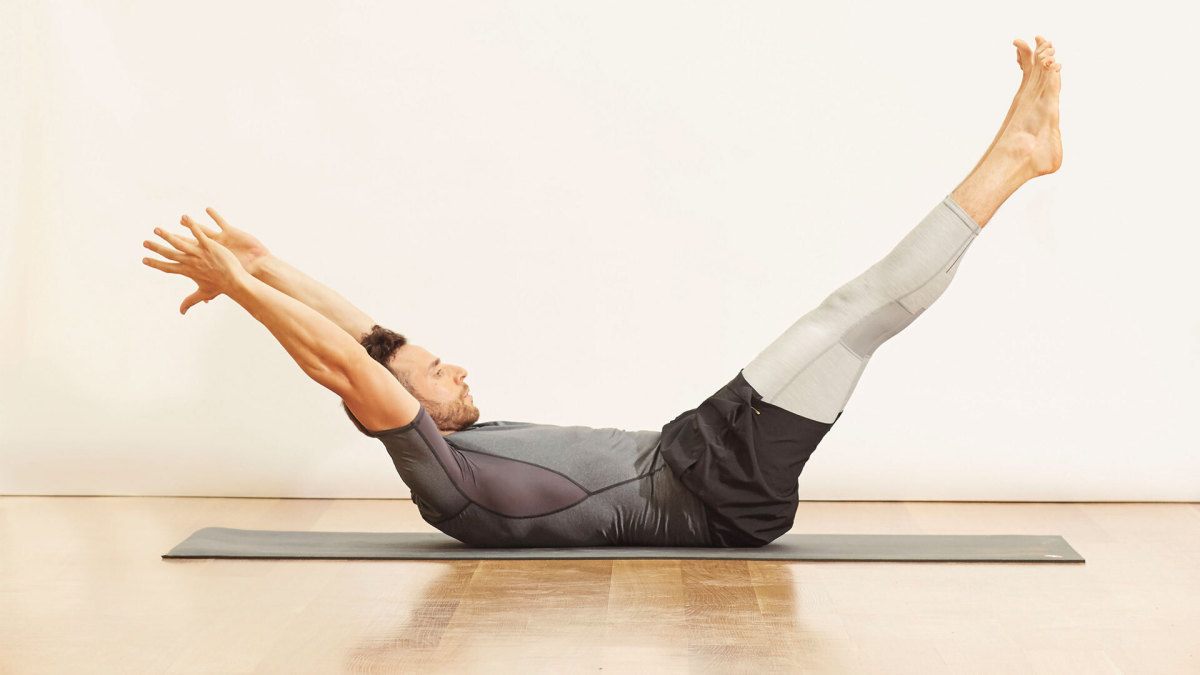
Justin Steele
The closer your torso is to perpendicular, the easier the move will be. And if you don’t have access to a GHD machine, you can perform hollow holds on the floor.
How to Do It
- Lie on your back with your arms and legs fully extended, squeezing everything tight, to start.
- Press your lower back into the ground and slightly lift your legs and upper back off the floor.
- If you’re a beginner, hold this position. If you’re more advanced, rock forward and back—holding the shape of a banana.
2. Toes to Bar
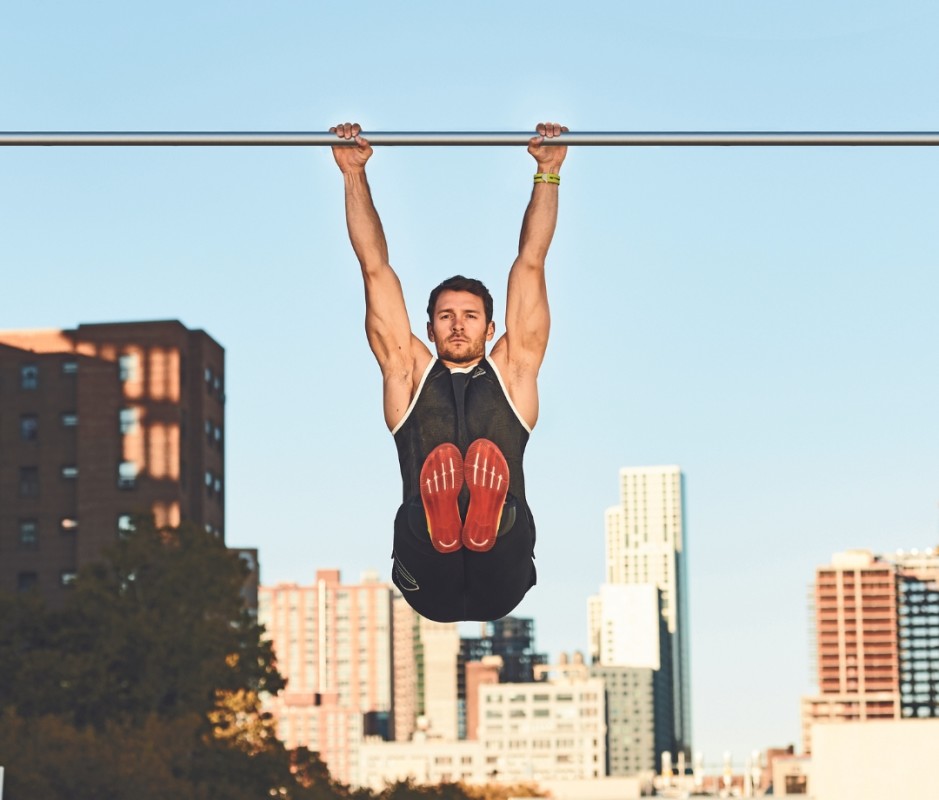
James Michelfelder
Why It’s Effective
Toes to bar does more than just build a six-pack: Studies have shown this type of move is one of the most effective for strengthening the obliques, even when done without twisting. Lyles does the full toes to bar variation.
How to Do It
- Hang from a pullup bar with straight arms set slightly wider than shoulder-width. Draw your shoulder blades back and down, to start.
- Keeping your feet together and legs straight, engage your core to hinge your hips, raising your legs until your toes touch the bar.
- Control your descent back to the starting position. That’s 1 rep.
- Perform 4 x 7-10 reps.
Easier Variation: Hanging Knee Raise
- Hang from a pullup bar with straight arms set slightly wider than shoulder-width. Draw your shoulder blades back and down, to start.
- Bend your knees and bring your thighs up until they’re parallel with the floor.
- As you advance, move on to a straight-leg raise, where your legs are extended straight from hips.
3. V-Up
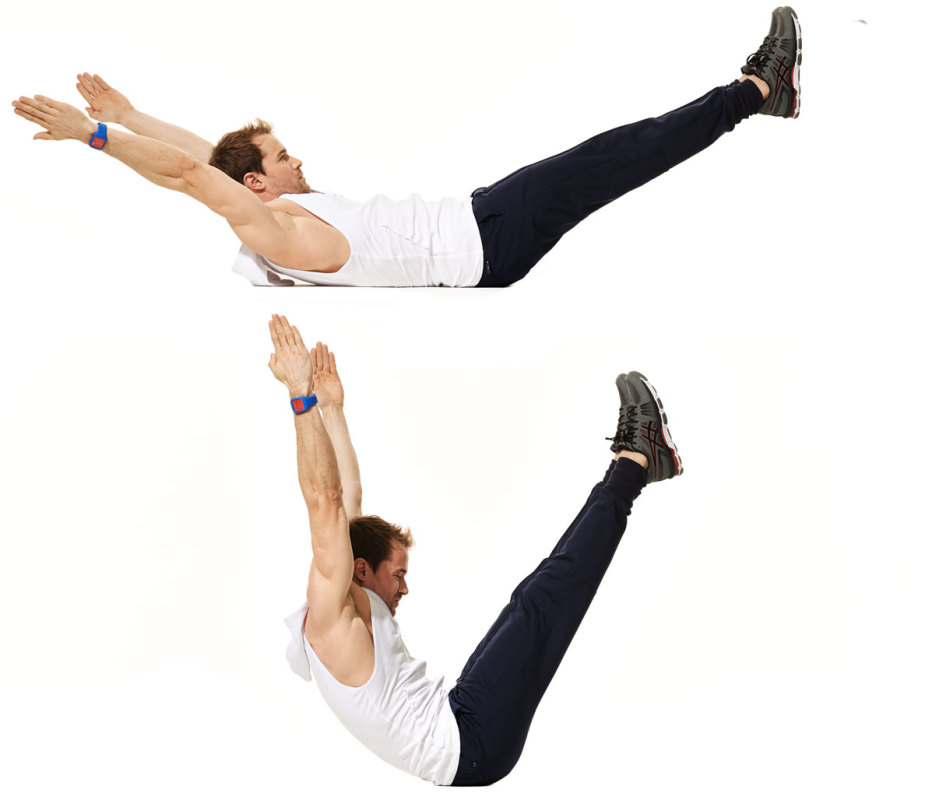
Why It’s Effective
For someone as strong as Lyles, this advanced sit-up might seem easy. To keep it challenging, he says, he’s uncompromising on form: “It has to be that V shape in the middle, and you have to be touching your toes,” he says, in order to get the full benefit.
How to Do It
- Lie on your back with your legs straight and arms overhead.
- Without bending your elbows or knees, contract your abdominal muscles, fold your body up by lifting your legs off the floor and stretch your arms toward your toes. Keep your back straight. As you rise, your body will form a “V” shape, and will then close like a venus fly trap.
- Pause, then return to the starting position. Do four sets of 20 repetitions.
Easier Variation: Deconstructed V-Up
If you’re flailing and throwing your torso up and down, split the move in two: Perform the upper body portion of the V-up, doing a situp with a straight back. Then do the lower body portion, raising your legs from the ground while your upper body is flat on the ground.
4. Star Plank

sergio_kumer/ Getty Images
Why It’s Effective
This move, Lyles says, is probably the most important in his core routine because it engages the core and the glutes at the same time. Running requires front and posterior muscles to work together in balance, and this trains just that.
To help fire up your glutes in this move, try getting into the side plank in a different way: Instead of lifting your hips off the floor laterally, do so from a position where your knees are slightly bent, and your feet are a little closer to your waist than they will be in the full side plank position. As you raise your body up, squeeze your butt to press your hips forward and take the bend out of your knees. As you do this, your feet will slide a bit on the ground into position.
How to Do It
- Get into a classic side plank position: Lie on your left side with your forearm on the floor directly under your left shoulder, with your legs and feet stacked. Have a slight bend in your knees.
- Prop yourself up on your elbow, and squeeze your glutes to straighten your legs as you assume the forearm side plank position so that your body forms a straight line from ear to ankles. To make this harder, perform the move with your left arm straight beneath you, balanced on your hand instead of your forearm.
- Straighten your top arm so that your torso forms a “T” shape.
- Without letting this rigid body line slacken and without bending your knee, raise your top leg (right) up away from your bottom leg. Your arms and legs will form an “X” or star shape.
- Hold this position for 15 seconds, then repeat on the other side. Perform 4 x 15-seconds holds.
Easier Variation: Side Plank
Too hard? Skip the star shape. Stop at step 3, and perform the four 15-second holds on each side.
5. Forearm Plank
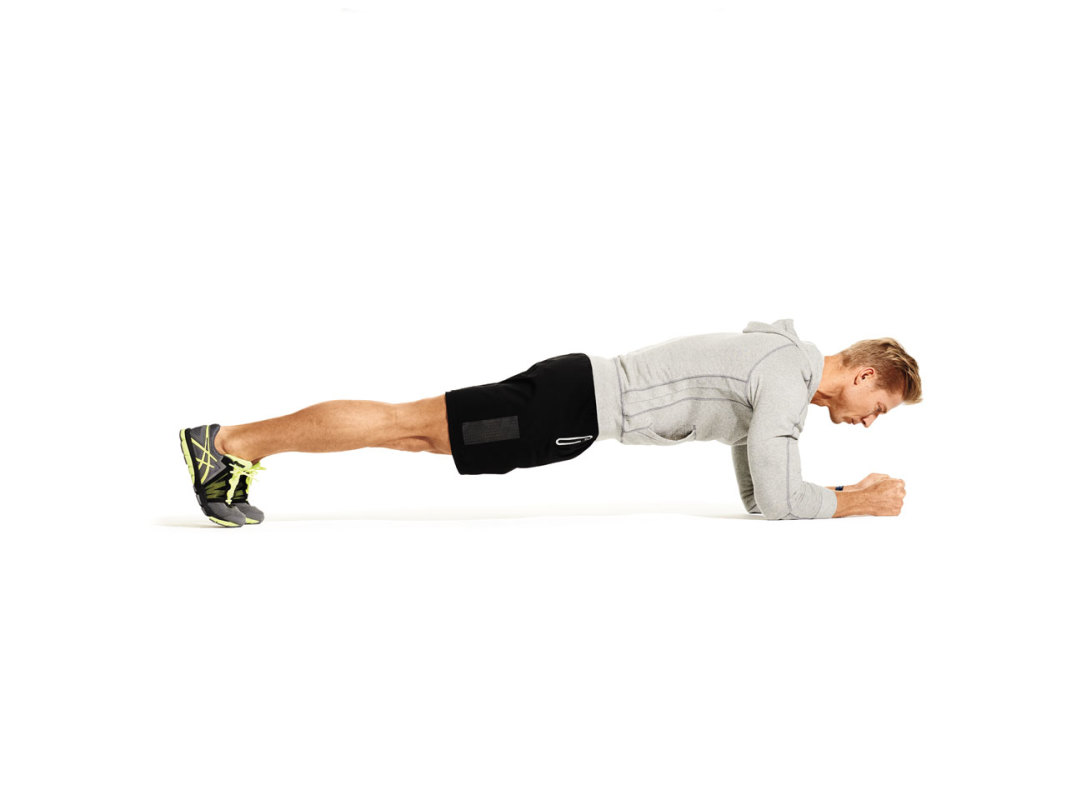
Beth Bischoff
Why It’s Effective
Don’t just hang out in a plank, Lyles says. Engage your core by drawing your belly button towards your spine. Feel your lats in your back firing. Squeeze your glutes. And grip the floor with your fingers. This, he says, will turn this “easy” move into a challenge.
How to Do It
- Assume a classic pushup position, but on your forearms: Prop yourself up so that your elbows are directly beneath your shoulders, palms facing down. Form a straight line from your head to heels.
- Engage your core, glutes, legs, and lats, and hold this rigid body line for one minute. Repeat for four total holds of one minute each.
Easier Variation: Plank From Knees
You can also perform planks on your knees. Instead of a rigid line from head to heels, maintain a rigid body line from head to knees.
6. Glute Kickback Machine

Getty Images
Note: This image depicts cable glute kickback, which is an alternative if you don’t have access to a glute kickback machine.
Why It’s Effective
“A lot of people think that this machine is about how far you can throw the weight up using your hamstring, but they’re missing the point,” Lyles says. “Your core should be more turned on than your hamstrings.”
Lyles says to concentrate on doing this move with purpose. “Go at a slower pace, and push the weight up and down with the same intent and same speed. You should feel every muscle working,” he says.
How to Do It
- Stand in the machine with your forearms resting on the pad, your hands on the handles, and one foot behind you against the plate. You should be bent forward at the hips. This is the starting position.
- Brace your core, and feel it engage as you press the weight back by using your glutes, not your hamstrings. Push back slowly.
- Return to the start, maintaining this same pace. Do four rounds of 6 reps on each side.
-

 African History5 years ago
African History5 years agoA Closer Look: Afro-Mexicans 🇲🇽
-

 African History6 months ago
African History6 months agoBlack History Facts I had to Learn on My Own pt.6 📜
-

 African History5 years ago
African History5 years agoA Closer Look: Afro-Mexicans 🇲🇽
-

 African History1 year ago
African History1 year agoMajor African Tribes taken away during the Atlantic Slave Trade🌍 #slavetrade #africanamericanhistory
-

 African History1 year ago
African History1 year agoCameroon 🇨🇲 World Cup History (1962-2022) #football #realmadrid #shorts
-

 African History6 months ago
African History6 months agoBlack History Inventors: Mary Kenner 🩸
-

 African History1 year ago
African History1 year agoNo African pre-Columbus DNA? 🤯🤯 #history #mesoamerica #mexico #african
-

 African History1 year ago
African History1 year agoOrigin Of ‘Cameroon’ 🇨🇲😳#africa

























